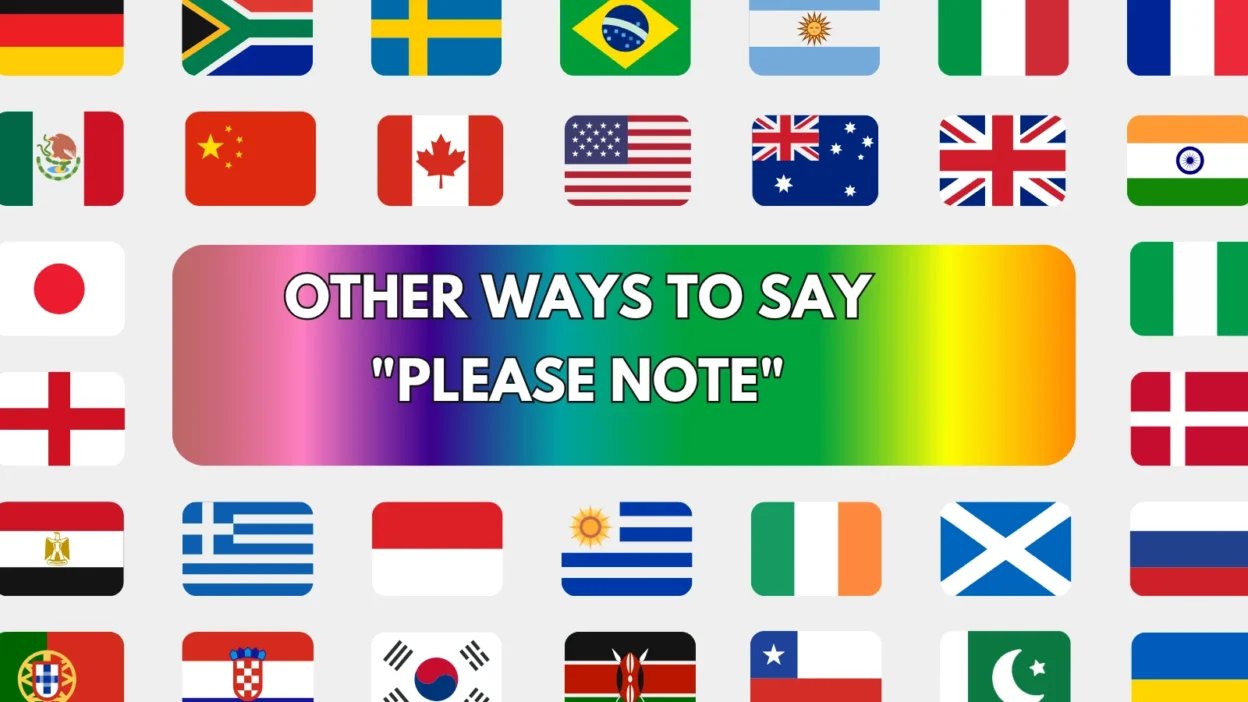The phrase “Please note” is a polite way to draw someone’s attention to important information. It’s commonly used in emails, formal documents, instructions, and announcements. While professional and respectful, it can sound overly repetitive or dry when used often.
This article presents 25 effective alternatives to “please note” that can help vary your tone — whether you’re writing formally, casually, or somewhere in between. These alternatives will help you sound clearer, more approachable, or more polished depending on the situation.
1. Kindly be advised
Meaning:
A polite way to inform someone of something important.
Detailed Explanation:
Used frequently in formal or business communication, this phrase maintains professionalism and courtesy while sharing essential details.
Scenario Example:
Kindly be advised that the meeting time has been moved to 3:30 p.m.
Best Use:
Formal emails, notices, policy updates.
Tone:
Polite, formal, respectful.
2. Just a reminder
Meaning:
Used to gently remind someone about something previously mentioned.
Detailed Explanation:
This phrase is friendly and less formal. It implies that the reader may already be aware of the information.
Scenario Example:
Just a reminder that reports are due by Friday afternoon.
Best Use:
Team emails, casual reminders.
Tone:
Friendly, conversational.
3. Keep in mind
Meaning:
Suggests someone should remember or consider something.
Detailed Explanation:
It’s a gentle and informal way to highlight a fact or condition, often used when giving advice or warnings.
Scenario Example:
Keep in mind that parking is limited near the venue.
Best Use:
Guides, instructions, informal messages.
Tone:
Casual, informative.
4. Be aware
Meaning:
Tells someone to take notice or be informed.
Detailed Explanation:
Used when it’s important that the reader acknowledges a fact or potential issue.
Scenario Example:
Be aware that system maintenance will begin at midnight.
Best Use:
Notices, warning emails, IT updates.
Tone:
Clear, neutral.
5. Please be aware
Meaning:
Adds politeness to a straightforward notice.
Detailed Explanation:
A slightly more formal version of “be aware,” softening the message and making it more respectful.
Scenario Example:
Please be aware that the application deadline is approaching.
Best Use:
Professional communication, formal updates.
Tone:
Polite, formal.
6. Take note
Meaning:
A direct instruction to pay attention to something.
Detailed Explanation:
Short and impactful, this phrase is great when you want to emphasize a change or fact.
Scenario Example:
Take note that the venue has changed to Conference Room B.
Best Use:
Announcements, formal notices.
Tone:
Firm, direct, professional.
7. It’s important to note
Meaning:
Highlights information that should not be overlooked.
Detailed Explanation:
Adds emphasis and introduces facts that support or clarify your main point.
Scenario Example:
It’s important to note that early registration offers a discount.
Best Use:
Reports, explanations, professional emails.
Tone:
Informative, formal.
8. For your information
Meaning:
Introduces helpful or necessary information.
Detailed Explanation:
Often abbreviated as FYI, it’s used to share relevant details without requiring action.
Scenario Example:
For your information, the server will be offline for updates this weekend.
Best Use:
Internal emails, updates, casual notices.
Tone:
Neutral, informative.
9. Please be advised
Meaning:
A formal way to inform someone of something important.
Detailed Explanation:
Similar to “kindly be advised,” but with slightly more formality and seriousness.
Scenario Example:
Please be advised that the policy has been updated effective immediately.
Best Use:
Official documents, legal notices.
Tone:
Formal, authoritative.
10. Remember
Meaning:
Asks someone to keep something in mind or not forget.
Detailed Explanation:
Simple and to the point — useful for reminders and instructions.
Scenario Example:
Remember to bring your ID card for entry.
Best Use:
Reminders, lists, casual communication.
Tone:
Direct, casual.
11. Just so you know
Meaning:
Casually introduces information that may be useful.
Detailed Explanation:
Informal and friendly, it can sound more conversational than “please note.”
Scenario Example:
Just so you know, we’re closing early today for maintenance.
Best Use:
Texts, casual messages, internal emails.
Tone:
Friendly, informal.
12. We’d like to inform you
Meaning:
Polite way to share official information.
Detailed Explanation:
Often used in customer or client-facing messages to present updates clearly.
Scenario Example:
We’d like to inform you that your subscription has been renewed.
Best Use:
Customer service emails, announcements.
Tone:
Polite, professional.
13. Please be reminded
Meaning:
Polite version of “just a reminder.”
Detailed Explanation:
Adds a formal touch, often used in repeated or scheduled notifications.
Scenario Example:
Please be reminded that the building will be closed on Friday.
Best Use:
Reminders, formal business communication.
Tone:
Respectful, polite.
14. Let me point out
Meaning:
Highlights specific information for consideration.
Detailed Explanation:
Often used in discussions or explanations to bring attention to a detail.
Scenario Example:
Let me point out that these figures are based on last year’s data.
Best Use:
Reports, presentations.
Tone:
Professional, slightly conversational.
15. Please keep in mind
Meaning:
Gently asks the reader to remember something.
Detailed Explanation:
Softens the message while still conveying importance.
Scenario Example:
Please keep in mind that seating is limited.
Best Use:
Customer communication, friendly notices.
Tone:
Polite, friendly.
16. Just a quick heads-up
Meaning:
Casual way to warn or inform someone about something in advance.
Detailed Explanation:
Useful when sharing important but non-urgent information.
Scenario Example:
Just a quick heads-up — the file may take a few minutes to download.
Best Use:
Team updates, informal notices.
Tone:
Casual, approachable.
17. Attention
Meaning:
Directly calls the reader to focus on something.
Detailed Explanation:
Often used in headers, signs, or notices to immediately grab attention.
Scenario Example:
Attention: The main elevator will be out of service until Thursday.
Best Use:
Signs, alerts, memos.
Tone:
Urgent, bold.
18. Let it be known
Meaning:
Declares something openly and clearly.
Detailed Explanation:
More dramatic or formal — often used in announcements or declarations.
Scenario Example:
Let it be known that the policy applies to all departments.
Best Use:
Official statements, proclamations.
Tone:
Formal, serious.
19. Be mindful that
Meaning:
Encourages awareness or careful thought.
Detailed Explanation:
Adds a thoughtful or considerate tone to your message.
Scenario Example:
Be mindful that deadlines may shift due to public holidays.
Best Use:
Instructions, polite reminders.
Tone:
Gentle, thoughtful.
20. Just a note to say
Meaning:
Introduces quick or simple information.
Detailed Explanation:
Casual and friendly, it’s a light way to start a message.
Scenario Example:
Just a note to say the schedule has been updated.
Best Use:
Emails, newsletters.
Tone:
Warm, informal.
21. Worth mentioning
Meaning:
Highlights something valuable or relevant.
Detailed Explanation:
Used when adding a helpful detail without making it sound too formal.
Scenario Example:
It’s worth mentioning that the software works best on Chrome.
Best Use:
Guides, blog posts.
Tone:
Helpful, casual.
22. It should be noted
Meaning:
A formal way to emphasize a detail.
Detailed Explanation:
Often used in research papers or structured reports.
Scenario Example:
It should be noted that this data reflects only one quarter.
Best Use:
Academic writing, analysis.
Tone:
Serious, formal.
23. For your attention
Meaning:
Signals that something important follows.
Detailed Explanation:
Used in formal letters or documents to ensure the reader pays close attention.
Scenario Example:
For your attention: new compliance protocols have been introduced.
Best Use:
Official memos, HR letters.
Tone:
Professional, direct.
24. Please be informed
Meaning:
Formally communicates information or changes.
Detailed Explanation:
Often used in notices or emails where you’re officially informing someone of a change or rule.
Scenario Example:
Please be informed that our office will be closed on Monday.
Best Use:
Formal notices, announcements.
Tone:
Respectful, serious.
25. You should know that
Meaning:
Introduces relevant or helpful information.
Detailed Explanation:
More conversational than formal, but still appropriate in many contexts.
Scenario Example:
You should know that the deadline has been moved up to Thursday.
Best Use:
Team emails, semi-formal writing.
Tone:
Direct, clear.
Conclusion
The phrase “please note” is effective, but using it too often can make your writing feel repetitive or overly formal. By choosing from these 25 thoughtful alternatives, you can keep your messages sounding fresh, polite, and appropriate to the context — whether you’re writing a formal announcement or a friendly email.




